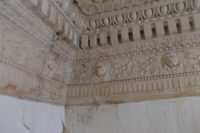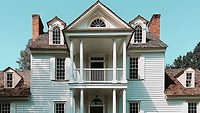Art Restoration: Historic Paintings Receive New Life After Water Loss






It was spring 2012 when an air conditioning unit in the attic above the Freeport Art Museum’s (FAM) storage facility malfunctioned, spewing water onto the ceiling tiles and floor, eventually coming into contact with several works of art. By the time it was discovered, many of the paintings had been damaged, notably with streak marks where the water had come into contact with the work and dripped down the art.
The Freeport Art Museum reached out to The Conservation Center and art appraisal firm Kramer and Associates in an effort to restore the damaged pieces of work to pre-loss condition.
Restoring First Steps
One of the affected pieces was by the 19th century Italian painter Luigi Agristi, titled First Steps. The oil on canvas painting exhibited ripples from the water damage, as well as a foot-long streak of dirt and grime. But that wasn’t all.
“Prior to the water damage, the piece had sustained multiple small rips and tears to the canvas as well as years of residue build-up,” says Carrie Baxter, Visitor Services and Business Manager, FAM.
Conservation Center conservators began by cleaning both sides of the canvas, followed by varnish removal, leaving the paint layer undisturbed. Tears on the canvas were then carefully aligned and mended with conservation adhesives. In order to flatten the painting and smooth out the ripples, a combination of heat, suction, humidity and weight techniques were utilized. After the piece was stretched to a new, custom-built stretcher, conservation-grade paints that are reversible and detectable to professionals were added to the areas of loss. Finally, the conservators applied a layer of varnish to integrate the surface. Due to the extensive damage to the original frame, the painting was reinstalled into a period reproduction frame, similar to the original, by The Center’s custom framing department.
“Staff members were not only able to clean the dirt and residue from the water damage, but they were also able to simultaneously make additional repairs that restored the painting’s visual integrity,” Baxter says.
Restoring Brimming Holland
Perhaps the most important piece of art restored during this whole process was the oil painting Brimming Holland by James Clarke Hook. The importance of the piece itself was something that FAM was unaware of until appraisal work done was done.
“The most interesting discovery for us was the provenance and exhibition history of Brimming Holland,” says Baxter. “James Clarke Hook was a 19th century academy painter who is quite well known in the art world. The piece in question was not only exhibited twice at the Royal Academy, London, but it has an excellent provenance. That is, we can trace who owned the painting and when it changed hands all the way back to the artist from the time it was given to the Freeport Art Museum.”
This type of discovery was the silver lining. However, Brimming Holland needed to recover from water damage and warranted conservation treatment - both to the painting and the frame. Paintings conservators at The Center, albeit with a patient and gentle touch, first had to stabilize the canvas. A thorough cleaning, followed by varnish removal and canvas flattening, had to be performed.
The process of inpainting was then carried out in areas of loss and abrasion using reversible conservation paints. Finally, a very fine layer of varnish was sprayed onto the surface. Separately from the painting, The Center’s frames and gilding department worked on bringing the original frame back to life. Miters were stabilized to ensure the frame’s solid structure and compo, gesso, and gilding were also consolidated with appropriate conservation adhesives. The conservator then inpainted new abrasions to emulate the surrounding surface, in addition to recasting and ingilding frame decorations.
Following the work, Brimming Holland once again brimmed with verve.
Looking for a reprint of this article?
From high-res PDFs to custom plaques, order your copy today!











